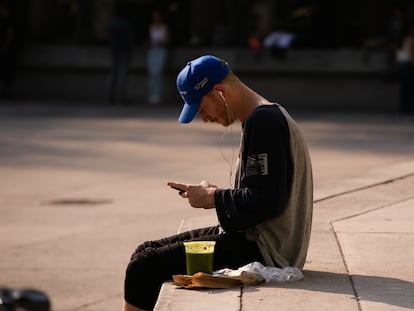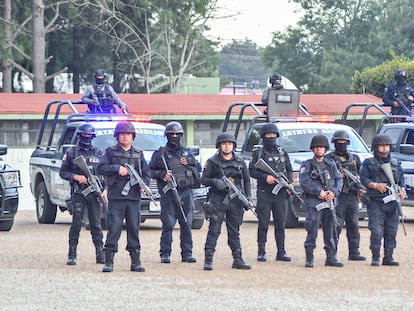The extradition of El Chelelo: The latest blow to Los Zetas
The story of Mexican drug trafficker Eleazar Medina Rojas is one of murder, fake identities, legal scandals and a nearly two-decade struggle to bring him to justice
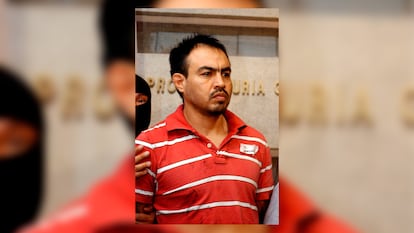
It was a discreet announcement. Mexico’s Attorney General’s Office (FGR) referred to Eleazar “El Chelelo” Medina Rojas as a Mexican national wanted by the United States for the crimes of criminal association and against health, and said that “between 2000 and 2010, he was the leader of a criminal organization dedicated to drug trafficking.”
But the statement did not include his last name, nor mention that the drug organization he had led was Los Zetas, one of the most feared criminal organizations in Mexico. Behind the brief statement on his extradition lies the story of one of Los Zetas’ most feared lieutenants, who the United States was after for more than two decades.
Almost immediately after he was handed over to U.S. agents at Mexico City International Airport, authorities announced that Medina Rojas, 51, was wanted in the United States for two charges of cocaine and marijuana trafficking. The White House identified him as one of the top commanders of La Compañia, a criminal organization forged from the alliance between the Gulf Cartel and Los Zetas. But the indictment was not new. It dates back 10 years to May 2013.
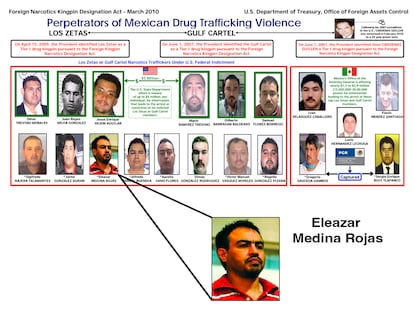
The indictment lists another 26 drug traffickers, including Miguel Treviño Morales, alias Z-40, the leader of Los Zetas; Heriberto Lazcano, known simply as “El Lazca,” and Antonio Cardenas Guillen, who is known as “Tony Tormenta” and is the brother of Osiel Cardenas, the founder of the Gulf Cartel. Antonio was killed in 2010 by Mexican armed forces in Tamaulipas, the historical stronghold of Los Zetas. Osiel pleaded guilty that same year in the United States and received a 25-year prison sentence. The Mexican government of Felipe Calderon (2006-2012) and his U.S. counterparts singled out Los Zetas as the main cause of violence in the country. It was just the first years of the drug war and Mexican authorities believed they had nearly completely dismantled the Gulf Cartel, a criminal organization that has made headlines in recent weeks.
El Chelelo had a lower profile, but played a key role in the criminal structure. Medina Rojas was the cartel’s boss in Monterrey, the country’s second most populous metropolitan area, and controlled several territories in the neighboring state of Tamaulipas. In April 2007, he was arrested along with seven accomplices in a large-scale operation in the border city of Nuevo Laredo. He was accused of “being one of the main murderers and kidnappers of the Gulf Cartel”.
The drug lord had tried to evade arrest by claiming a fake identity as Erick Gonzalez Martinez. But it was hard to pull off. The agents found $170,000 in cash, several luxury cars, an arsenal of long and short weapons, high-caliber pistols covered in gold-plated brass, more than a dozen bulletproof vests and more than a million pesos worth of jewelry. Calderón had been in power for less than six months, but the wave of violence due to the war on drugs was already dominating the news. The 2007 arrest of El Chelelo was hailed by the Attorney General’s Office (PGR) and then-secretary of public security Genaro García Luna as the second most important blow to the drug cartels, behind only the seizure of more than $207 million from Chinese businessman Zhenli Ye Gon, which occurred a month before.
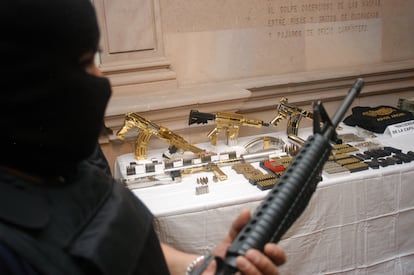
It was not El Chelelo’s first encounter with the justice system. In 1996, he was arrested with 153 kilos of marijuana but, according to the PGR, was released thanks to an amparo, a remedy for the protection of constitutional rights. At the 2007 press conference to announce his arrest, the PGR also linked him to at least one murder case and trying to enter the United States without papers. For an undisclosed period of time, he was in the custody of agents in Laredo, Texas. But Medina Rojas escaped, and reappeared on the other side of the border as one of Mexico’s deadliest drug lords.
After being arrested, Medina Rojas received an eight-year prison sentence. And in 2008, he was charged by the United States. But his extradition to the U.S. never materialized, despite the fact that during the Calderon administration (2007-2012), 587 defendants were extradited to the U.S. By way of comparison, under the government of Enrique Peña Nieto (2013-2018), there were only 394 extraditions, according to data from U.S. Congress.
After serving his sentence, El Chelelo went straight back to business. U.S. authorities say he played a key role in coordinating drug shipments to his home country between 2000 and February 2010, even though he was in prison in Mexico during the latter part of those years. They also accuse Medina Rojas and other cartel members of operating in countries such as Panama, Colombia and Guatemala. In March 2010, he was blacklisted by the Treasury Department and all his assets in the international banking system were frozen. This took place while he was serving his sentence. By 2016 he was out of prison and active again.
At the end of 2018, El Chelelo made an unexpected misstep. He was arrested for committing a traffic violation in an exclusive area of Merida in Yucatán. Just as he did a decade earlier, Medina Rojas used a fake name and ID, calling himself Máximo Tomás Roberto. But his profile fit the description given by the U.S. Drug Enforcement Agency (DEA). “The fugitive may be armed and dangerous,” it warned. After being found out, he threatened the officers who had detained him, according to several local media outlets. “You don’t know who you’re messing with,” he warned them.
#FGR, entregó en extradición al Gobierno de #EUA, a una persona de nacionalidad mexicana requerida por la Corte Federal de Distrito para el Distrito de Columbia, por los delitos de asociación delictuosa y contra la salud. Fungió como líder de una organización criminal dedicada al… pic.twitter.com/Yr1DPlGa4v
— FGR México (@FGRMexico) July 9, 2023
In another twist in the story, to the astonishment of the authorities, the judge handling his case argued that the traffic violation was not reason enough to keep him in jail and ordered his release. At the same time that he was being released from prison, Interpol was coordinating an operation to recapture him. When El Chelelo became aware of this, he refused to leave the court. Finally, he was handcuffed, escorted by agents and transferred in a government plane to the Altiplano maximum security prison, which is reserved for highly dangerous prisoners.
El Chelelo was notified of the U.S. extradition order as soon as he set foot in Altiplano prison, the same one from which notorious drug trafficker Joaquín “El Chapo” Guzmán escaped from via a mile-long tunnel in July 2015. Medina Rojas managed to delay the judicial process for another five years, until his extradition was announced last Sunday night. He handed himself over last Thursday. After being in and out of jail for almost 30 years, Medina Rojas will face a new trial in the District of Columbia.
Sign up for our weekly newsletter to get more English-language news coverage from EL PAÍS USA Edition
Tu suscripción se está usando en otro dispositivo
¿Quieres añadir otro usuario a tu suscripción?
Si continúas leyendo en este dispositivo, no se podrá leer en el otro.
FlechaTu suscripción se está usando en otro dispositivo y solo puedes acceder a EL PAÍS desde un dispositivo a la vez.
Si quieres compartir tu cuenta, cambia tu suscripción a la modalidad Premium, así podrás añadir otro usuario. Cada uno accederá con su propia cuenta de email, lo que os permitirá personalizar vuestra experiencia en EL PAÍS.
¿Tienes una suscripción de empresa? Accede aquí para contratar más cuentas.
En el caso de no saber quién está usando tu cuenta, te recomendamos cambiar tu contraseña aquí.
Si decides continuar compartiendo tu cuenta, este mensaje se mostrará en tu dispositivo y en el de la otra persona que está usando tu cuenta de forma indefinida, afectando a tu experiencia de lectura. Puedes consultar aquí los términos y condiciones de la suscripción digital.
More information
Archived In
Últimas noticias
Most viewed
- Oona Chaplin: ‘I told James Cameron that I was living in a treehouse and starting a permaculture project with a friend’
- Reinhard Genzel, Nobel laureate in physics: ‘One-minute videos will never give you the truth’
- Sinaloa Cartel war is taking its toll on Los Chapitos
- Why the price of coffee has skyrocketed: from Brazilian plantations to specialty coffee houses
- Silver prices are going crazy: This is what’s fueling the rally

